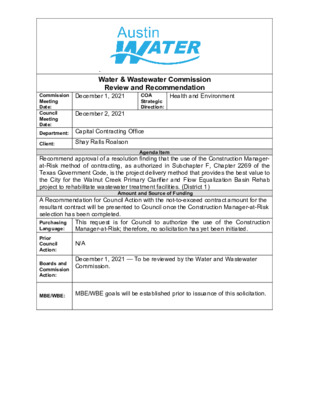B6 — original pdf
Backup

- Water & Wastewater Commission Review and Recommendation Health and Environment December 1, 2021 Commission Meeting Date: Council Meeting Date: Department: Capital Contracting Office December 2, 2021 COA Strategic Direction: Client: Shay Ralls Roalson Agenda Item Recommend approval of a resolution finding that the use of the Construction Manager- at-Risk method of contracting, as authorized in Subchapter F, Chapter 2269 of the Texas Government Code, is the project delivery method that provides the best value to the City for the Walnut Creek Primary Clarifier and Flow Equalization Basin Rehab project to rehabilitate wastewater treatment facilities. (District 1) Amount and Source of Funding A Recommendation for Council Action with the not-to-exceed contract amount for the resultant contract will be presented to Council once the Construction Manager-at-Risk selection has been completed. This request is for Council to authorize the use of the Construction Manager-at-Risk; therefore, no solicitation has yet been initiated. N/A December 1, 2021 — To be reviewed by the Water and Wastewater Commission. MBE/WBE goals will be established prior to issuance of this solicitation. Purchasing Language: Prior Council Action: Boards and Commission Action: MBE/WBE: State Statute governs construction procurement for municipalities. The standard method of contracting used for construction services is competitive bidding in which the contract is awarded to the lowest responsive bidder. Texas Government Code Chapter 2269 allows for methodologies alternate to the low bidding method which may provide the best value to the municipality. These alternate methodologies include: Competitive Sealed proposals, Construction Manager-at-Risk, Design-Build, and Job Order Contracting. Texas Local Government Code Section 252.022(d) allows the City to adopt and use an alternative method such as Construction Manager-at-Risk (CMR) under Chapter 2269 of the Texas Government Code if such a method provides a better value for the City. The CMR method is a project delivery method in which the City contracts with an architect/engineer to perform design services and separately contracts with a CMR to perform preconstruction and construction phase services. The role of the CMR goes beyond performing general construction services. The CMR is under contract early in the design process to perform key preconstruction phase services to collaborate with the City and the design team regarding scope and constructability, optimize the design, control costs, and establish budgets; and establish quality assurance-quality control protocols. After the design is complete and before the CMR begins construction, the City will negotiate and execute a Guaranteed Maximum Price for the remainder of the work, including actual construction. A CMR firm will be selected by a City-staffed evaluation panel that will evaluate and score proposals based on published evaluation criteria to determine the highest ranked proposer. As set forth in Government Code 2269, the City of Austin will select a CMR firm that will provide the “best value” to the City for preconstruction and construction services for the Project. Walnut Creek Wastewater Treatment Plant (WWTP) is permitted to treat and discharge an average daily flow of 75 million gallons per day (MGD) and a 2-hour peak flow of 165 MGD. Treated plant effluent is discharged into the Colorado River. A portion of treated plant effluent is used for non-potable water on the plant site and supplies much of the City’s growing Water Reclamation Initiative program. Primary Treatment Complex No. 1 is original to the 1977 construction, and Primary Treatment Complex No. 2 was added in the late 1980s. The purpose of this project is to rehabilitate and make improvements to the Primary Treatment Complexes (PTC) at Walnut Creek WWTP. Each PTC consists of two trains of primary clarifiers and in-line flow equalization basins (FEBs). Raw wastewater flows through the primary clarifiers, then continues to the in-line FEBs. Settled wastewater is pumped to secondary treatment, and primary sludge is pumped to Hornsby Bend Biosolids Management Plant. Most of the mechanical and other components in PTC No. 1 and No. 2 are beyond their useful life. Typically, primary clarifiers and FEBs are located above ground and are easily accessible which allows for traditional and straight forward construction. At Walnut Creek WWTP, however, the primary clarifiers and FEBs are in enclosed underground structures with virtually no construction access for replacement of the large clarifier equipment. As a result, there are many challenges, complexities, and risks associated with delivering this project which makes it an ideal candidate for the proposed CMR delivery method. Due to the limited construction access, the replacement of the large clarifier mechanisms will require nonstandard equipment manufacturing and structural modifications to the existing underground roof structures to enable installation of the clarifier mechanisms. The CMR delivery method will allow the contractor to determine early on what alternative means and methods are required to successfully carry out the rehabilitation of the treatment complexes. In addition, schedule is a high priority to rehabilitate the critical equipment associated with this project. The CMR delivery method may allow for the release of equipment purchase packages earlier than is possible with other delivery methods. The possibility of shifting the purchase of long lead time equipment out of the construction phase and into the pre-construction phase may result in a schedule advantage as compared with the traditional design–bid–build approach. These challenges will require very close coordination with the design consultant, contractor, equipment manufacturers, and fabricators during the design phase. The CMR delivery method is expected to reduce project risk and constructability concerns may also expedite the construction schedule. The estimated construction budget for this work is $26,400,000 and it is anticipated that construction will begin October 2023. A delay in authorization of the methodology will result in a delay in the issuance of the solicitation and will affect the ability to perform these improvements in a timely manner. It is important for this project to move forward because of the criticality of the equipment in the wastewater treatment process. If the project is not approved and delayed, Walnut Creek WWTP’s ability to reliably accept and treat wastewater may be impacted. This solicitation and evaluation process is approximately six months.